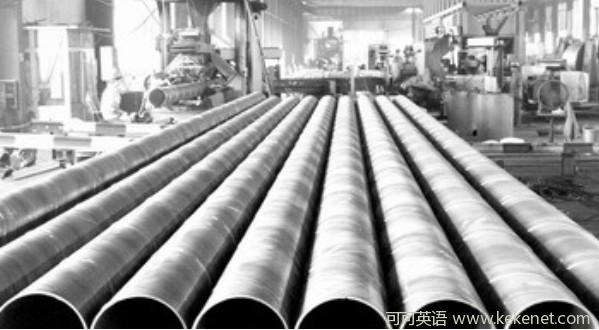
Business
商業(yè)
Energy Transfer bids for Sunoco
ETP競(jìng)購(gòu)Sunoco
Put that in your pipe
納入油管中
A pipeline deal to exploit America's fast-changing energy landscape
美國(guó)能源局勢(shì)快速多變,一樁油氣管道交易抓住了契機(jī)
NODDING donkeys, offshore platforms, refineries and filling stations are the bits of the oil industry you can see. A vast and largely invisible network of underground pipes joins them all together. It is worth a lot, which is why Energy Transfer Partners (ETP) said it would pay $5.3 billion for Sunoco on April 30th. It hopes to pull together two networks and shift more of America's booming oil and gas output.
抽油機(jī),海上鉆井平臺(tái),煉油廠還有加油站,你看見的這些只是石油工業(yè)的冰山一角。把它們連在一起的是一個(gè)龐大且?guī)缀蹼[形的地下管網(wǎng)。它價(jià)值不菲,正因如此 ETP 公司于4月30日表示,愿意出價(jià)53億美元收購(gòu) Sunoco 公司。美國(guó)國(guó)內(nèi)的石油和天然氣產(chǎn)量正快速增長(zhǎng),ETP 希望通過(guò)合并兩家公司的管網(wǎng),以輸送更多油氣產(chǎn)品。
ETP is ambitious. Last year its parent company, Energy Transfer Equity, agreed to buy Southern Union and its gas-pipeline network for $5.7 billion.The latest deal will make ETP the country's second-biggest pipeline firm, behind Kinder Morgan, after the latter's merger with El Paso is concluded later this year.
ETP 公司躊躇滿志。去年其母公司 ETE 同意出價(jià)57億美元,收購(gòu) Southern Union 公司及其天然氣管網(wǎng)。最新的收購(gòu)將使ETP成為全美第二大油氣管道公司。Kinder Morgan 公司并購(gòu) El Paso 之后排名第一,其交易今年晚些時(shí)候完成。
Sunoco comes with storage facilities, 4,900 filling stations and the remains of a refining business that it is trying to spin off in a joint venture with Carlyle, a private-equity firm. But the pipelines are the main attraction. ETP currently operates 17,500 miles (28,160km) of the arteries that transport gas and natural-gas liquids such as propane and butane. Adding Sunoco's 6,000 miles, built to carry crude oil and refined products, will reduce ETP's reliance on gas. After the deal, 30% of its revenues will come from oil.
收購(gòu)帶來(lái)了 Sunoco 公司的儲(chǔ)油設(shè)施、4900個(gè)加油站以及一家煉油廠的剩余資產(chǎn)。Sunoco 打算把這些剩余資產(chǎn)剝離出來(lái)投入一家合資公司,該合資公司由ETP和私募股權(quán)公司Carlyle共同投資。但最誘人的部分是油氣管道。ETP目前運(yùn)營(yíng)的油氣管道干線達(dá)17500英里(約28160公里)。這些干線用于輸送天然氣以及丙烷、丁烷等液化天然氣。加上 Sunoco 運(yùn)輸原油和精煉產(chǎn)品的6000英里管道,ETP對(duì)天然氣輸送業(yè)務(wù)的依賴程度將降低。交易完成后,ETP 30%的收入將來(lái)自石油輸送業(yè)務(wù)。
This is important. In a few years shale gas's share of America's total gas output has gone from almost nothing to around a fifth. It will account for much more in the years to come. This changes the logistics of energy delivery, says Ronald J. Barone of UBS, a bank. Shale gas is much more widely distributed than the conventional sort. It is also more scattered than the ports through which imported gas arrives.
這一點(diǎn)意義重大。近年來(lái),在美國(guó)天然氣總產(chǎn)量中,頁(yè)巖氣的比例幾乎從零上升至五分之一。今后幾年,這一比例將進(jìn)一步提高。瑞士聯(lián)合銀行的 Ronald J. Barone 認(rèn)為,能源運(yùn)輸?shù)奈锪鞣绞接纱烁淖儭Ec傳統(tǒng)天然氣相比,頁(yè)巖氣的分布更廣泛。與進(jìn)口天然氣的港口位置相比,頁(yè)巖氣的分布也更普遍。
The more shale gas America uses, the more local the energy business becomes. Deliveries from gas basins in the south-west to the markets of the heavily populated Atlantic seaboard in the north-east are dwindling. The development of the Marcellus shale is displacing long-distance supplies with gas from Pennsylvania, Ohio and West Virginia.
頁(yè)巖氣用得越多,美國(guó)的能源業(yè)務(wù)就越趨本地化。從西南天然氣盆地到東北嚴(yán)重污染的大西洋沿岸,天然氣輸送量正在縮減。Marcellus 頁(yè)巖氣的開發(fā)利用開始取代賓夕法尼亞、俄亥俄以及西弗吉尼亞的遠(yuǎn)距離天然氣供應(yīng)。
Transporting gas still brings big and stable revenues. But diversifying into oil makes sense too. America's oil pipelines are largely unfettered by the rigid regulations that govern gas-pipeline tariffs. So transporting gloopy oil is far more profitable than shifting lighter-than-air gas.
天然氣運(yùn)輸帶來(lái)的收入仍然豐厚,而且穩(wěn)定。但業(yè)務(wù)擴(kuò)展到輸油領(lǐng)域也很有意義。在美國(guó),輸氣管道要繳納的關(guān)稅被法規(guī)嚴(yán)格規(guī)定,而輸油管道幾乎沒(méi)有這種束縛。因此,與輸送比空氣還輕的天然氣相比,輸送粘稠的石油收益要高得多。
And the oil business is looking peachy. A barrel of West Texas Intermediate fetches around $100, even as gas prices recently hit a ten-year low. This has encouraged gas producers to scurry after oil in liquid-rich shale beds such as the Bakken in North Dakota. To do this, they use the same rigs and techniques, such as fracking and horizontal drilling, as they use for gas. Within a few years the Bakken and other shale beds could be producing up to 3m barrels of oil a day, reckon optimists. That is around a third of current imports.
原油業(yè)務(wù)看起來(lái)也相當(dāng)不錯(cuò)。盡管最近天然氣的價(jià)格跌至十年來(lái)的低點(diǎn),每桶WTI 原油價(jià)格仍在100美元上下徘徊。受此刺激,天然氣生產(chǎn)商急忙去含油豐富的頁(yè)巖層里尋找石油,如北達(dá)科他的貝根頁(yè)巖層。他們用同樣的鉆井和技術(shù),如水力壓裂和水平鉆井去找油。樂(lè)觀估計(jì),幾年內(nèi)貝根及其他頁(yè)巖層的產(chǎn)能將升至日產(chǎn)三百萬(wàn)桶原油。這相當(dāng)于目前原油進(jìn)口量的三分之一。
Owning the pipes that make all this possible should be lucrative. America has long failed to invest in pipes, since investors assumed that the country would continue to rely on imports. So there is too little capacity in many places where it is now needed. And American buyers are clamouring for more oil from Canada, which will also need pipes. Targets like Sunoco are rare. ETP was wise to swoop on it.
擁有油氣管道使所有這些想法成為可能,并有利可圖。由于投資者認(rèn)為美國(guó)將持續(xù)依賴進(jìn)口石油,長(zhǎng)期以來(lái)都未在油氣管道上進(jìn)行投資。因此許多地方幾乎沒(méi)有油氣輸送能力,而現(xiàn)在需要管道。美國(guó)買家也在呼吁增加加拿大石油的進(jìn)口量,這同樣也需要管道。Sunoco 這種收購(gòu)對(duì)象少之又少,ETP一舉拿下可謂明智。



